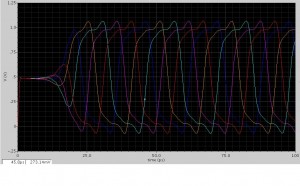Circuit Simulation Using a Verilog-A Implementation of the Virtual-source Transistor Model
- Category: Circuits & Systems, Electronic Devices
- Tags: Dimitri Antoniadis, Luca Daniel, Omar Mysore
A variety of compact MOSFET models are used for circuit simulation in both industry and academia, ranging from standard industrial models with dimensional and processing parameter dependencies [1] to simple, intuitive physical transport models. The virtual-source model (VS model), a recently developed, simple, semi-empirical, short channel MOSFET model, captures the essential physics with relatively few physical parameters, most of which can be directly determined from device measurements or simulations [2] . Because of its accuracy, simplicity, and scalability, the VS model is excellent for technology benchmarking, performance projection and variability analysis.
Previous work on this project involved the implementation of the VS model, including intrinsic charges, in a commercial simulator using Verilog-A, an analog descriptive language. Commercial circuit simulators allow users to create Verilog-A behavioral modules, which specify the relationships between currents and voltages of the internal and external nodes of the module. Using such a module, the VS model, including intrinsic charges, was implemented in Verilog-A. This project uses the Verilog-A implementation of the model to simulate a number of circuits.
Circuits such as ring oscillators, adders, and FIR-filters were simulated in commercial simulators using the Verilog-A implementation of the VS model. Ring oscillators ranging from fan-out one to seven were implemented, and the delays were compared to experimental data from fabricated ring oscillators. For the ring oscillators, the appropriate VS model parameters were extracted from measured data, and the parameters were varied in simulations in order to obtain sensitivity analyses. The node voltages of a fivestage ring oscillator are shown in Figure 1. For larger circuits, such as an FIR-filter, when convergence difficulties arose, smoothing functions substantially improve convergence. Based on the circuits implemented as part of this project, using Verilog-A modules in commercial simulators is an adequate method of simulating circuits with the VS model.
- C. Hu. “BSIM.” Internet: http://www-device.eecs.berkeley.edu/~bsim3/bsim4.html [June 31, 2009]. [↩]
- A. Khakifirooz, “A simple semiempirical short-channel MOSFET current-voltage model continuous across all regions of operation and employing only physical parameters,” IEEE Transactions on Electron Devices, vol. 56, pp. 1674-1680, 2009. [↩]
